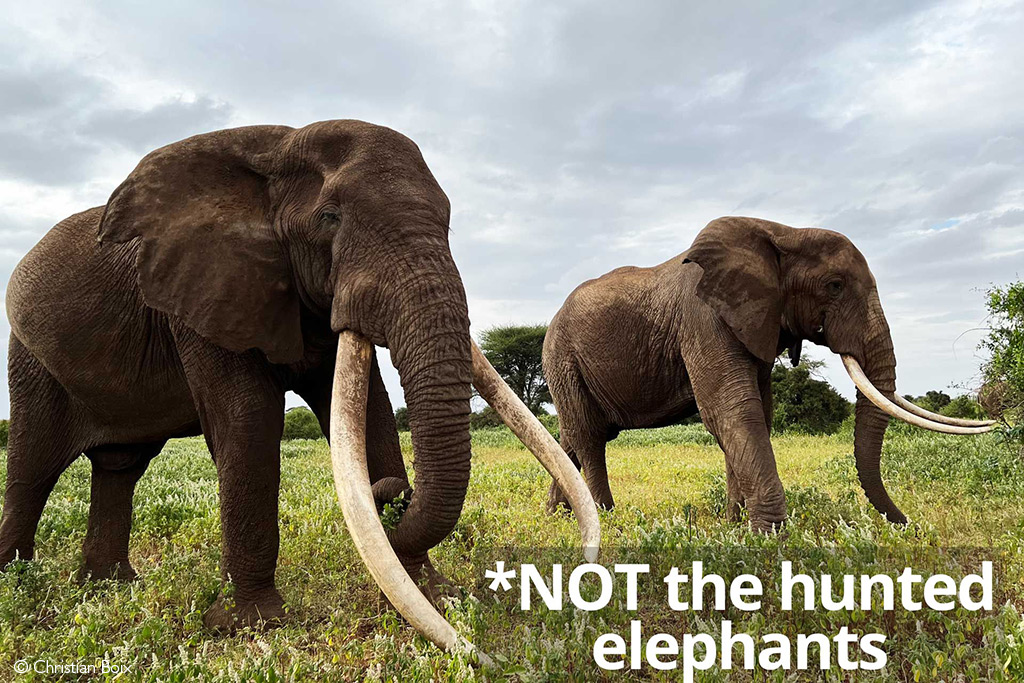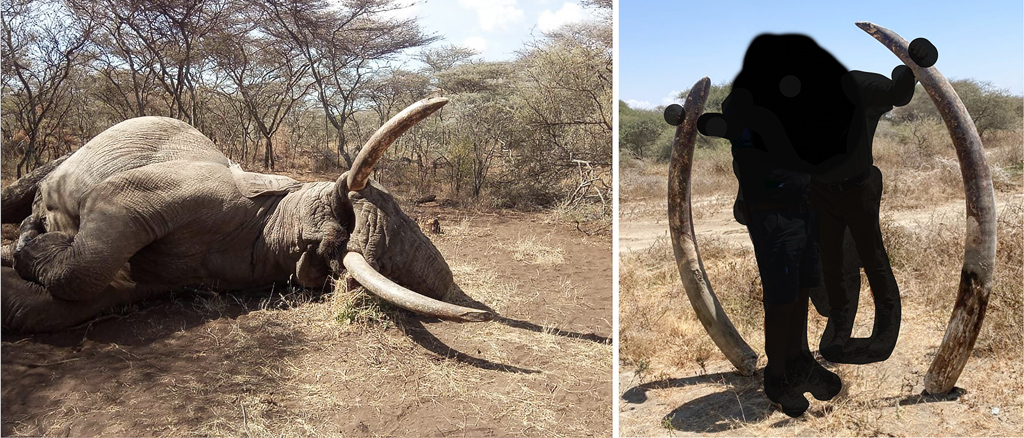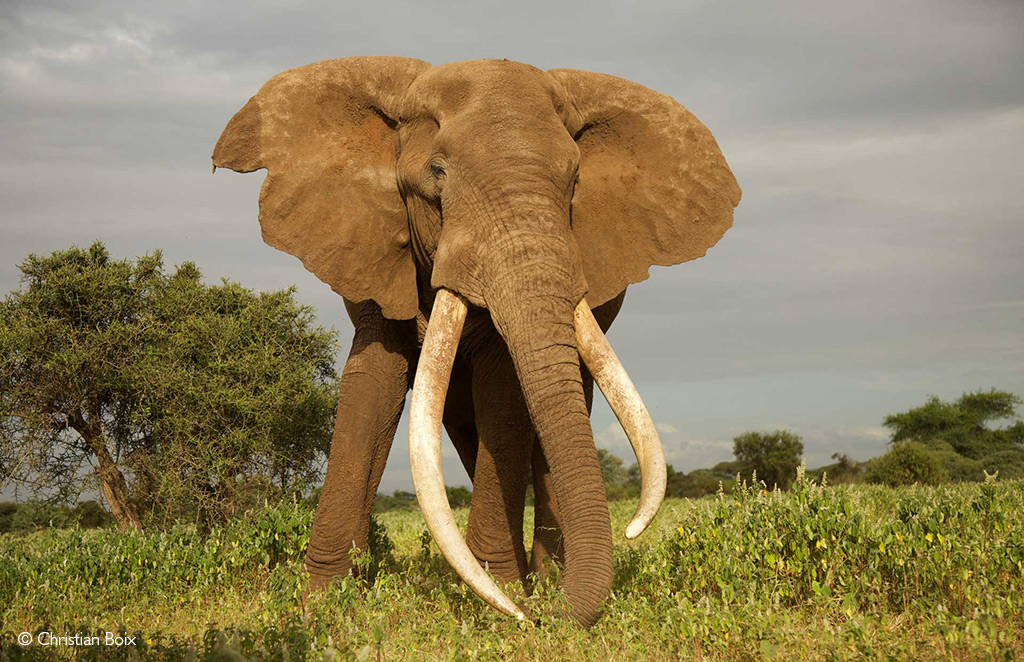
Update 23/04/2024: We can confirm that two more large-tusked elephants have been trophy hunted in Tanzania near the Kenya border. A fourth elephant was hunted in Enduimet on 11 April – likely from the Amboseli elephant population. A fifth elephant was hunted in Longido, to the west of Enduimet, during the week of 14 April. The hunts were allegedly conducted by the same hunting outfitter that hunted previous elephants in the area and involved high profile members of Tanzania’s hunting fraternity. Our sources advise that unscrupulous outfitters are willing to violate the moratorium on hunting along the Kenya/Tanzania border, with no regard for the precarious state of Amboseli’s dwindling super tusker population. Meanwhile, those with detailed information are on lockdown, nervous to reveal details for fear of persecution – while petitions to the Tanzanian government fall on deaf ears.
Update 28/03/2024: Africa Geographic is now able to share photos taken shortly after the first trophy hunt that took place in Enduimet, showing the carcass and tusks of super tusker Gilgil. In the first image, Gilgil’s carcass can clearly be seen, and in the second, the tusks, removed from the carcass (measuring 99 pounds and 110 pound), are visible.

Update 14/03/2024: Amboseli Trust for Elephants has positively identified the first trophy-hunted bull as Gilgil, a breeding elephant aged 35, who would have been approaching his prime reproductive years. Male elephants reach their prime breeding years at or about 40 years. Our sources confirm Gilgil was a ‘100-pounder’, with one tusk weighing 99 pounds and the other 110 pounds.
Trophy hunted: 2 super tuskers in Tanzania
10 January 2024 – A trend of Tanzanian trophy hunters targeting ‘100-pounder’ elephants has raised concerns of a new threat to the last few remaining super tuskers, of which as few as 50–100 may still be alive today.
In recent months, trophy hunters have killed two super tuskers – bulls with at least one 100-pound tusk – close to Tanzania’s border with Kenya. This greater Amboseli ecosystem is a famous haven for these giant elephants, where many have become habituated as a result of close interaction with humans. The trend of targeting these ecologically and economically important animals requires immediate critical attention.
What we know about these two super-tusker hunts:
- Two ‘super-tusker’ elephants (defined in East Africa as elephants with at least one tusk weighing 100 pounds) were trophy hunted in the West-Kilimanjaro area of northern Tanzania in the latter half of 2023. West-Kilimanjaro includes the Enduimet Wildlife Management area, surrounding government-owned land and private ranches.
- Two different hunting companies were responsible.
- In both cases, the hunters burnt the elephant carcasses – an uncommon practice amongst hunting operators in Tanzania.
- All super tuskers are individually known to conservation organisations, but the identity of these elephants has not yet been established. The burning of the carcasses made post-mortem ID impossible.
- All information at hand suggests that the required permits were in place for both trophy hunts.

Super tusker 1 – September 2023
- The first hunt took place in Enduimet Wildlife Management Area in September 2023.
- The elephant was killed approximately 24km from the international border between Tanzania and Kenya.
- There are unconfirmed reports that the hunting operator identified the specific super tusker while the elephant was outside the hunting block and targeted the elephant shortly after it crossed into the hunting zone.
- Africa Geographic contacted the relevant hunting operator and requested information about the elephant in question, such as images and tusk sizes. The operator responded to our message but refused to provide the requested information.
Update 14/03/2024: Amboseli Trust for Elephants has positively identified the first trophy-hunted bull as Gilgil, a breeding elephant aged 35, who would have been approaching his prime reproductive years. Male elephants reach their prime breeding years at or about 40 years. Our sources confirm Gilgil was a ‘100-pounder’, with one tusk weighing 99 pounds and the other 110 pounds.
Super tusker 2 – November 2023
- The second hunt occurred in November 2023 on a piece of land neighbouring Enduimet Wildlife Management Area – approximately 36km from the international border between Tanzania and Kenya.
- A helicopter was observed flying extensively in the area in the days preceding the hunt. Using an aircraft to find or coerce target animals is considered extremely unethical by responsible trophy hunters.
- Africa Geographic contacted the relevant hunting operator and requested information about the elephant in question, such as images and tusk sizes. The operator responded to our message but refused to divulge any information and was, unfortunately, somewhat disparaging of our requests for transparency.
About super tuskers and this cross-border elephant population
- There are estimated to be between 50 and 100 elephants remaining in Africa with at least one tusk weighing 100 pounds or more. Most of these roam the unfenced regions of southern Kenya and northern Tanzania, but some are still found in Southern Africa. The population has been decimated by the combined impacts of the ivory trade (legal and poached), human-wildlife conflict and trophy hunting. Read more about the trophy hunting of super tuskers here (Botswana) and here (Zimbabwe).
- There are regulations governing a minimum tusk size requirement for trophy-hunted elephants in Tanzania, but no stipulation of a maximum tusk or body size.
- Decades of scientific research confirm that the West-Kilimanjaro region in Tanzania and Amboseli in Kenya, are part of one functional ecosystem with shared wildlife populations. Well-known tuskers such as Craig and Tee-Jay roam this unfenced region.
- The Amboseli elephant population is one of the best protected in the world and the subject of the world’s longest-running population study. Being extremely habituated, this elephant population is also one of the primary attractions that make Amboseli National Park one of Kenya’s top three most-visited national parks.
- Eight young Amboseli males were recently satellite-collared to determine the behaviour and range of young males who had recently left their natal families. Two of these males spend most of their time in Tanzania, near Enduimet, Tinga Tinga and beyond. Earlier radio-collaring of older males also showed extensive and frequent movement between Kenya and Tanzania.
- Enduimet area: “For some of the big males, the Enduimet area is part of their non-musth range when they are fairly sedentary. Once in musth, they will range across most of the Amboseli ecosystem, which is cross-border,” said Cynthia Moss, director of Amboseli Trust for Elephants during an email discussion with Africa Geographic.
- Amboseli elephants are habituated to vehicles and also to people on foot because they live among the Maasai people. Photographers lie on the ground to photograph the magnificent giant elephants as they stroll close by unconcerned. “Shooting an Amboseli bull is about as sporting as shooting your neighbour’s poodle,” said Moss in an interview conducted in 1996.

The ‘value’ of elephants – the science and ethics
The debate on justification for sport-hunting elephants continues, and government policies vary widely across Africa. However, there are specific reasons why targeting ‘super-tuskers’ is ill-advised:
- Genetic scarcity: Following centuries of selective removal by the ivory trade (legal and poached) and trophy hunters, genes for large tusks are becoming increasingly rare, as evidenced by the scarcity of big-tusked elephants. There are estimated to be between 50 and 100 elephants remaining in Africa with one tusk weighing 100 pounds or more.
- Breeding value: Long-term research has shown that males between 40–54 years (which have the largest tusks) have the highest reproductive success.
“Elephant males continue to go through yearly musth cycles well into their 50s. When they are in musth, they roam far and wide to find females for mating,” said Moss.
She further explained:
“Females exercise choice, and they prefer to mate with older males in musth. Elephant males only start coming into musth in their late 20s, but it is the older males in their 40s and 50s that the females choose. Elephants grow throughout their lifetime, and their tusks grow faster in their last decade of life. When a female chooses a mate, she chooses one for his age, which indicates health and robustness. These older males have proven their genetic quality because they have survived to an older age. We have no indication that the females are choosing males with larger tusks. However, the larger tusks are an advantage to a male in a fight.”
- Social value: Older bulls are also important in elephant society for their control of behaviour in younger bulls. Older male elephants – whether they have big tusks or not – are important to other, younger males in teaching and setting examples. They are also important friends and companions to other elephants.
- Economic value: The Greater Amboseli Ecosystem contains some of the most economically valuable and best-known elephants on the planet – like Craig – that are a primary attraction for tourists to the Greater Amboseli Ecosystem and a pillar of an industry which generates millions of dollars in revenue every year. The trophy fee to hunt the largest category of elephant in Tanzania is approximately $20,000. The average elephant’s lifetime value from attracting tourists is estimated at $1,607,625 – while the value of a large-tusked individual would be much higher. Killing one of the last remaining giant elephants on Earth for the benefit of one hunting operator and client appears to be a huge waste of revenue opportunity, aside from other important conservation issues discussed here.
- Ethical considerations: The debate about sport-hunting a highly social, long-lived, intelligent animal continues. However, these questions are amplified in this context when the elephants being killed are extremely habituated and trusting due to good protection and frequent interactions with tourists.

Craig – Amboseli super tusker © Christian Boix
Historic ban on trophy hunting of these cross-border tuskers
When considering a solution, there is a precedent for exactly this situation. After three well-known Amboseli elephants were killed by sport hunters near the Kenya-Tanzania border in 1994, authorities from both countries were apparently able to reach an agreement to ban hunting “along the border” until Kenya and Tanzania could best decide how to manage hunting tourism in this area. According to a newspaper article, this agreement was announced by then Principal Secretary of the Tanzanian Ministry of Natural Resources, Tourism and Environment, Dr. Ben Moshi, but we have not been able to source a copy of such an agreement. However, it would appear that there was a historic solution that was mutually acceptable and respected until recently, and this could be revisited.
Our search for specifics about the hunting of these tuskers:
Enduimet management, the Tanzania Wildlife Management Authority, and the Tanzania Hunting Operators Association were all approached for comment and have yet to respond. Relevant information will be added to this article as we receive responses.
To comment on this story: Login (or sign up) to our app here - it's a troll-free safe place 🙂.![]()






